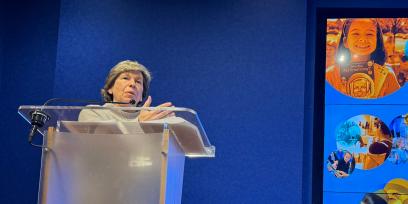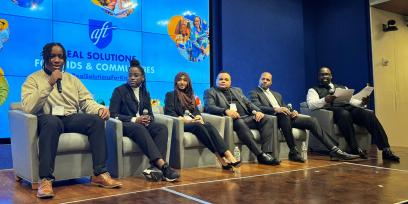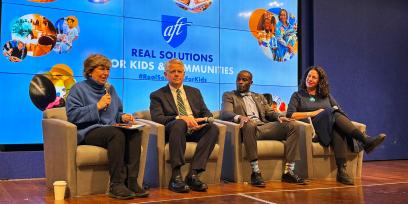More than 100 people from 19 school districts gathered in New York City for the annual Center for School Improvement Leadership Institute Jan. 18-20. Braving frigid temperatures and snowy forecasts, these educators and administrators marked the 31st year of a conference known for bringing together teams of different stakeholders, and creating space for them to hammer out solutions specific to the challenges their students and communities face. Co-sponsored by the AFT and the United Federation of Teachers, this year’s conference focused on career and technical education, one of the top “real solutions” in the AFT’s campaign for supporting schools and communities.
Communication, collaboration and critical thinking are key to CTE, AFT President Randi Weingarten told participants at the beginning of the conference. Students don’t just learn career skills, they learn to work together—and CSI participants modeled that approach, problem-solving their way through workshops, panel discussions and roll-up-your-sleeves work sessions, crafting real-world solutions to eventually apply back home.
This sort of collaboration also addresses larger problems, Weingarten said. She played a clip of Maryland Gov. Wes Moore, who framed service learning and experiential learning as keys to overcoming the divisiveness that plagues our political system. Working together, “We learn the ways of problem-solving,” said Weingarten. “That’s what experiential learning does.”
Measuring success
On a more everyday scale, CTE keeps kids in school. “We already know that CTE students graduate at a higher rate than their academic counterparts,” said Leo Gordon, vice president of CTE high schools for the UFT. When teachers can connect what is happening in the classroom to actual career opportunities, students pay attention in a whole new way. “It is life-changing for all of your students every day,” he said.
New York City has a 91 percent graduation rate among CTE students compared with the non-CTE student rate of 81 percent, said UFT President Michael Mulgrew. At one school, the Brooklyn STEAM Center, the graduation rate is 100 percent. Students tell Mulgrew that CTE makes learning “real” for them and helps them imagine what their futures might look like. “This is the better way,” said Mulgrew. “We have the data to prove it.”
The conference offered myriad examples of CTE successes. New York State United Teachers President Melinda Person described meeting a middle school student building a snowboard out of cardboard and duct tape: “He told me, ‘this is why I come to school.’”
And CTE is not just about hard skills. When Person asked one of the students involved in robotics competitions what he was learning, she expected him to describe coding or engineering. Instead, the student told her: “I learned how to respect my opponent, and I learned how to be a good teammate.”
“The types of skills they need for 21st-century careers are happening in our CTE classrooms,” she said. “This stuff is magic. The more we can expand it across our state and across our nation, the better off our students will be.”
So, what makes these programs work? Gordon suggested four main components: a strong academic curriculum; faculty who are highly trained in their content area; a full sequence of CTE-related credits; and, most important, partnerships with industries that will welcome students when they graduate. “Those partnerships are what keeps your programs strong,” said Gordon.
The Brooklyn STEAM Center is a prime example. Located at the Brooklyn Navy Yard, a complex of more than 500 businesses from high tech to the creative arts, its students show up to school as employees, not students. “It’s intentionally designed to look nothing like a school,” says Brooklyn STEAM Principal Kayon Pryce. Instead, spaces simulate the sorts of workspaces students will occupy upon graduation. The proximity to actual businesses also “allows our programs to grow and respond to changes in those sectors,” said Pryce.
Brooklyn STEAM partnerships with postsecondary schools also allow students to earn up to 25 college credits, and multiple industry credentials are also available. Students, who come from eight different high schools, work paid jobs throughout their time at Brooklyn STEAM.
“Coming to the Brooklyn STEAM Center opened a vast number of doors for me in terms of opportunities,” said Nia Davis, a 12th-grader specializing in cybersecurity. She described multilayered projects—like breaking into her teacher’s Wi-Fi network and merging two companies together. Niari Smith, another cybersecurity student at Brooklyn STEAM, found he was able to do the work, but less capable when it came to communicating it to executives in a presentation. The program helped him learn how to better articulate his work.
Key tools and resources
Outside the plenary sessions and panel discussions, participants attended workshops to pick up communication skills and learn about the power of data to track program success and help convince those who might support CTE that the investment is well worth it. Mini-workshops included deep dives into tapping student leadership potential, youth employment programs, CTE for special education and neurodiverse students and English language learners, and sessions on the New York Harbor School and SkillsUSA competitions.
Participants also learned about resources available through federal programs from a panel of agency leaders. Amy Loyd, assistant secretary in the Office of Career, Technical and Adult Education for the U.S. Department of Education; Manny Lamarre, senior adviser of workforce development for the U.S. Department of Labor; and Scott Jensen, director of workforce strategy for the CHIPS office in the U.S. Department of Commerce, urged conference participants to “dream big,” because there is money available for the kinds of CTE programs that will support their communities.
Funding ranges from Perkins financial assistance and Every Student Succeeds Act grants to funding from the Workforce Innovation and Opportunity Act. Some programs offer mental health supports and child care assistance; others invest in young adults impacted by the justice system. There is a job corps, apprenticeship programs and workforce pathways for youth.
“If we dream it, these three people will help us fund it,” said Weingarten, who moderated the discussion with the government representatives.
“It’s a solid effort across the board,” said Krista O’Connor, high school vice president of the Petaluma Federation of Teachers in California, who was especially interested in those federal programs. Her district has a strong foundation in CTE, and the conference was “a really good way to pull a lot of it together.”
Sean Perkins, a member of the Washington Teachers’ Union in Washington, D.C., said seeing CTE in action was especially inspiring, and the workshop on using data to advance CTE programs most impressive: “I’m a math teacher so I ate that up,” he said, adding that he’ll use what he learned in his classroom.
The conference “made us think about reimagining how we do things and how to bring joy back to career and technical ed,” said Christopher Green, an English teacher and a member of the Boston Teachers Union.
As Weingarten said, “If we don’t bring the joy back, who’s going to do it for us?”
[Virginia Myers]



